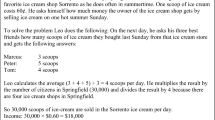Abstract
This research study examines the development of the ability of pre-service teachers to notice signs of students’ understanding of the derivative concept. It analyses preservice teachers’ interpretations of written solutions to problems involving the derivative concept before and after participating in a teacher training module. The results indicate that the development of this skill is linked to pre-service teachers’ progressive understanding of the mathematical elements that students use to solve problems. We have used these results to make some suggestions for teacher training programmes.
Similar content being viewed by others

References
An, S. & Wu, Z. (2012). Enhancing mathematics teachers’ knowledge of students’ thinking from assessing and analysis misconceptions in homework. International Journal of Science and Mathematics Education, 10, 717–753.
Artigue, M. (1990). Advanced mathematical thinking. In D. Tall (Ed.), Analysis (pp. 167–198). Dordrecht: Kluwer Academic Publishers.
Asiala, M., Cottrill, J., Dubinsky, E. & Schwingendorf, K. (1997). The development of students’ graphical understanding of the derivate. Journal of Mathematical Behavior, 16, 399–431.
Baker, B., Cooley, L. & Trigueros, M. (2000). A calculus graphing schema. The Journal for Research in Mathematics Education, 31, 557–578.
Ball, D. L., Thames, M. H. & Phelps, G. (2008). Content knowledge for teaching: What makes it special? Journal of Teacher Education, 59, 389–407.
Bartell, T. G., Webel, C., Bowen, B. & Dyson, N. (2013). Prospective teacher learning: Recognizing evidence of conceptual understanding. Journal of Mathematics Teacher Education, 16, 57–79.
Badillo, E., Azcarate, C. & Font, V. (2011). Análisis de los niveles de comprensión de los objetos f’(a) y f’(x) en profesores de Matemáticas. Enseñanza de las Ciencias, 29(2), 191–206.
Biza, I., Christou, C. & Zachariades, T. (2008). Student perspectives on the relationship between a curve and its tangent in the transition from Euclidean Geometry to Analysis. Research in Mathematics Education, 10(1), 53–70.
Biza, I., Nardi, E. & Zhachariades, T. (2007). Using tasks to Explñore teacher knowledge in situation-specific contexts. Journal of Mathematics Teacher Education, 10, 301–309.
Clements, D. & Sarama, J. (2004). Learning trajectories in mathematics education. Mathematical Thinking and Learning, 6(2), 81–89.
Fernández, C., Llinares, S. & Valls, J. (2012). Learning to notice students’ mathematical thinking through on-line discussions. ZDM Mathematics Education, 44, 747–759.
Fernandez, C., Llinares, S. & Valls, J. (2013). Primary school teacher’s noticing of students’ mathematical thinking in problem solving. The Mathematics Enthusiast, 10, 441–468.
Ferrini-Mundy, J. & Graham, K. (1994). Research in calculus learning. Understanding limits, derivates and integrals. In J. Kaput & E. Dubinsky (Eds.), Research issues in undergraduate mathematics learning, MAA notes 33 (pp. 31–45). Washington, DC: Mathematical Association of America.
Franke, M. L. & Kazemi, E. (2001). Learning to teach mathematics: Focus on student thinking. Theory in Practice, 40(2), 102–109.
García, M., Llinares, S. & Sánchez-matamoros, G. (2011). Characterizing thematized derivative schema by the underlying emergent structures. International Journal of Science and Mathematics Education, 9, 1023–1045.
Habre, S. & Abboud, M. (2006). Student’s conceptual understanding of a function and its derivative in an experimental calculus course. The Journal of Mathematical Behavior, 25, 57–72.
Jacobs, V. R., Franke, M. L., Carpenter, T. P., Levi, L. & Battey, D. (2007). Professional development focused on children’s algebraic reasoning in elementary school. Journal for Research in Mathematics Education, 38, 258–288.
Jacobs, V. R., Lamb, L. C. & Philipp, R. A. (2010). Professional noticing of children’s mathematical thinking. Journal for Research in Mathematics Education, 41, 169–202.
Magiera, T. M., van den Kieboom, L. A. & Moyer, J. (2013). An exploratory study of pre-service middle school teachers’ knowledge of algebraic thinking. Educational Studies in Mathematics. doi:10.1007/s10649-013-9472-8.
Mason, J. (2002). Researching your own practice. The discipline of noticing. London: Routledge Falmer.
Nagle, C., Moore-Russo, D., Viglietti, J. & Martin, K. (2013). Calculus students’ and instructors’ conceptualizations of slope: A comparison across academic levels. International Journal of Science and Mathematics Education, 11(6), 1491–1515.
Sánchez-matamoros, G., García, M. & Llinares, S. (2006). El desarrollo del esquema de derivada [The development of derivative schema]. Enseñanza de las Ciencias, 24(1), 85–98.
Sánchez-matamoros, G., García, M. & Llinares, S. (2008). La comprensión de la derivada como objeto de investigación en Didáctica de la Matemática [The understanding of derivative as an research topic in Mathematics Education]. RELIME-Revista Latinoamericana de Investigación en Matemática Educativa, 11, 267–296.
Spitzer, S., Phelps, C. M., Beyers, J. E. R., Johnson, D. Y. & Sieminski, E. M. (2011). Developing prospective elementary teachers’ ability to identify evidence of student mathematical achievement. Journal of Mathematics Teacher Education, 14, 67–87.
Strauss, A. & Corbin, J. (1994). Grounded theory methodology: An overview. In N. K. Denzin & Y. Lincoln (Eds.), Handbook of qualitative research (pp. 273–285). Thousand Oaks: Sage.
van Es, E. A. & Sherin, M. G. (2008). Mathematics teachers “learning to notice” in the context of a video club. Teaching and Teacher Education, 24, 244–276.
Wilson, P. H., Mojica, G. F. & Confrey, J. (2013). Learning trajectories in teacher education: Supporting understandings of students’ mathematical thinking. Journal of Mathematical Behavior, 32, 103–121.
Zandieth, M. (2000). A theoretical framework for analyzing student understanding of the concept of derivative. In E. Dubinsky, A. H. Shoenfeld & J. Kaput (Eds.), Research in collegiate mathematics education IV CBMS issues in mathematics education (Vol. 8, pp. 103–127). Providence, USA: American Mathematical Society.
Author information
Authors and Affiliations
Corresponding author
Rights and permissions
About this article
Cite this article
Sánchez-Matamoros, G., Fernández, C. & Llinares, S. DEVELOPING PRE-SERVICE TEACHERS’ NOTICING OF STUDENTS’ UNDERSTANDING OF THE DERIVATIVE CONCEPT. Int J of Sci and Math Educ 13, 1305–1329 (2015). https://doi.org/10.1007/s10763-014-9544-y
Received:
Accepted:
Published:
Issue Date:
DOI: https://doi.org/10.1007/s10763-014-9544-y



